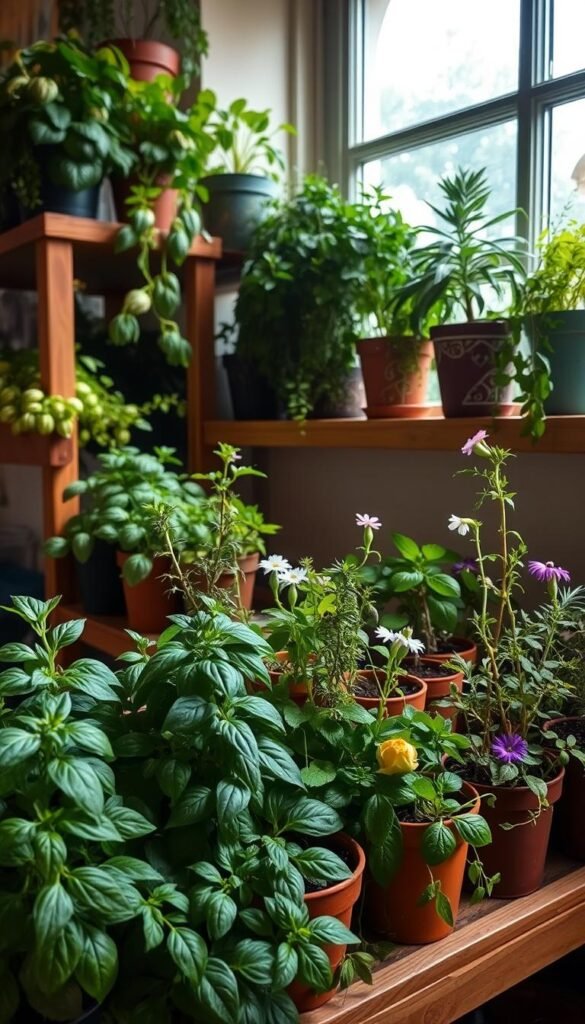Imagine snipping fragrant leaves straight from your countertop to elevate tonight’s dinner. Growing culinary plants in creative vessels combines practicality with personality, turning everyday meals into flavor adventures. You don’t need sprawling outdoor beds – even apartment dwellers can cultivate thriving greenery using clever container solutions.
Sunny windowsills become aromatic havens when filled with basil, thyme, or mint. Old baskets find new purpose cradling rosemary, while wooden crates transform into rustic planters. Our favorite trick? Using vertical space with stacked containers that let trailing varieties like oregano cascade beautifully.
The magic lies in matching plants to your lifestyle. Prefer low-maintenance options? Try hardy chives or parsley that forgive occasional forgetfulness. Love experimenting? Grow exotic varieties like lemon balm or purple basil. Best part? These living decorations purify air while providing instant ingredients.
Whether you upcycle vintage tins or showcase modern geometric planters, your arrangement becomes edible art. We’ll guide you through selecting ideal varieties, perfect placements for sunlight, and simple care routines. Get ready to transform unused corners into vibrant, useful displays that make every dish taste like a chef’s creation.
Overview of Indoor Herb Gardens
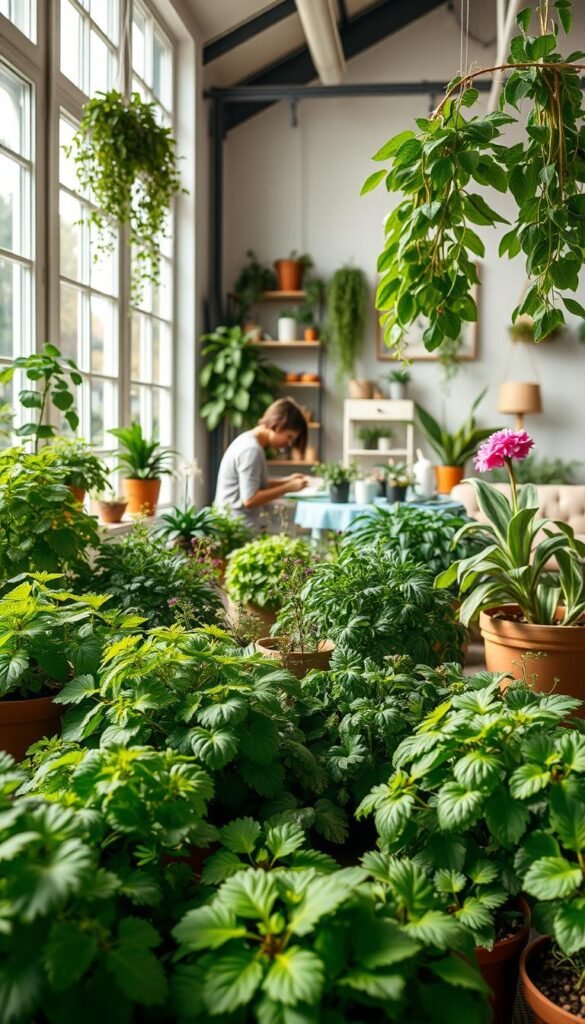
Picture reaching over your morning coffee to pluck fresh basil for an omelette. This daily magic happens when culinary plants become part of your kitchen’s rhythm. Unlike outdoor plots, these compact setups thrive where you cook, creating instant access to vibrant flavors.
Understanding the Benefits of Indoor Gardening
Growing plants inside does more than save grocery trips. Studies show tending greenery reduces stress by 37%—a natural mood booster. Your space stays fresher too, as common varieties like rosemary purify air while growing.
See how homegrown options outshine store-bought:
| Homegrown | Store-Bought | |
|---|---|---|
| Cost per month | $1.20 | $8.50 |
| Shelf life | 3+ months | 5 days |
| Flavor intensity | High | Medium |
How Indoor Herb Gardens Transform Your Kitchen
That empty corner above the sink? Perfect for a mint planter. Windowsills become flavor stations where you pinch thyme for soups or cilantro for tacos. “My kitchen smells like an Italian trattoria every afternoon,” shares Los Angeles cook Emma R.
These living displays turn meal prep into sensory joy. You’ll notice deeper connections to food—crushing homegrown oregano releases brighter aromas than jarred spices. Even better? No dirt trails—modern self-watering pots keep counters clean.
Getting Started with Your Indoor Herb Garden
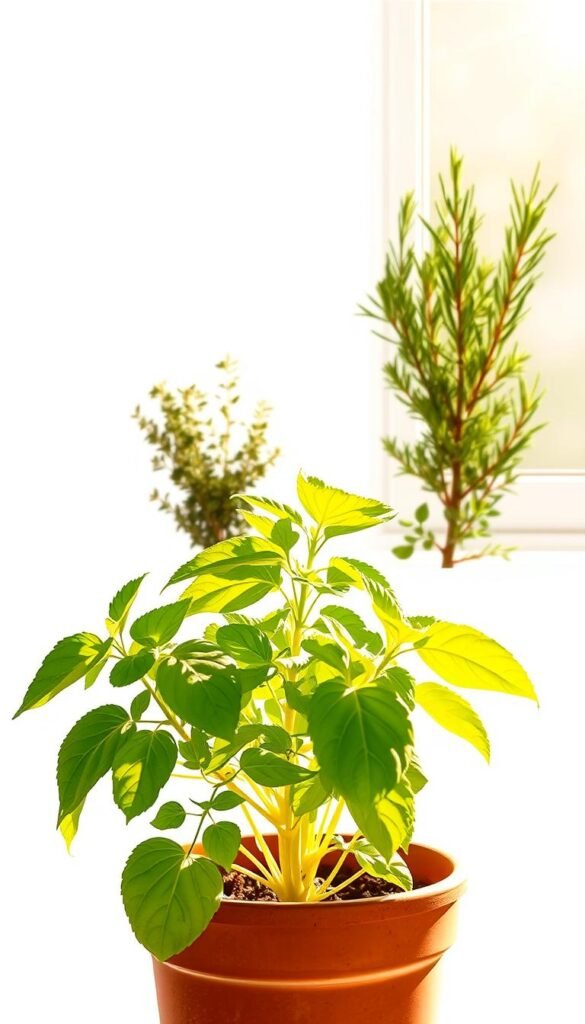
Your next culinary adventure starts with soil and sunlight. Begin by picking 2-3 favorite flavors like peppermint or parsley—varieties that adapt well to kitchen life. Success hinges on two fundamentals: smart placement and proper supplies.
Selecting the Ideal Sunny Spot
Most culinary plants crave bright conditions. Use this quick guide to evaluate your space:
| Location | Daily Light | Best Herbs |
|---|---|---|
| South window | 6-8 hours | Basil, Rosemary |
| East window | 4-6 hours | Thyme, Oregano |
| Countertop w/grow light | Adjustable | Mint, Chives |
Track sunlight patterns for 3 days using sticky notes. Chef-turned-gardener Marco T. suggests: “Mark where shadows fall each hour—you’ll spot the sweet zones.” Rotate pots weekly for even growth if light comes from one direction.
Gathering Essential Tools and Quality Potting Soil
Drainage matters more than container style. Repurpose old mugs by drilling holes, or use store-bought pots. Pair vessels with premium mixes—look for these features:
- Lightweight texture with perlite
- Slow-release fertilizers
- pH between 6.0-7.0
Cheap dirt compacts over time, suffocating roots. Pro tip: Moisten potting soil before planting—it helps seeds settle evenly. Keep a spray bottle nearby for gentle watering while plants establish.
With your sunniest corner identified and supplies ready, you’re set to grow flavors that transform ordinary meals. Remember—consistent care beats perfection. Those first tender leaves will taste sweeter knowing you nurtured them!
Indoor Herb Garden Ideas: Unique Containers and Stylish Displays
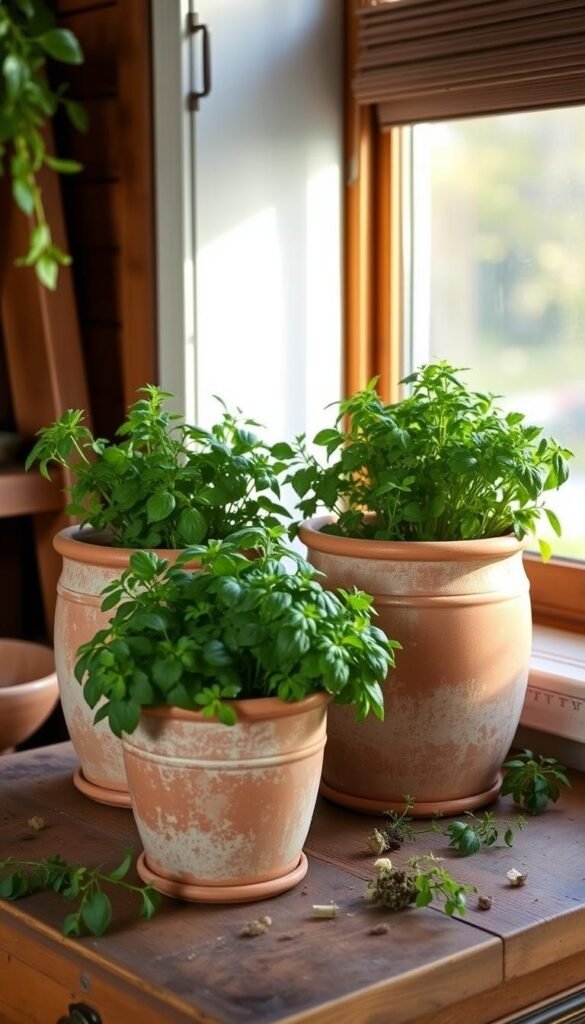
Transform your kitchen into a living gallery where greenery meets design. The right vessels elevate your plants from functional to focal points, blending personality with practicality.
Exploring Vintage and Upcycled Planters
Old washtubs and galvanized pails add instant rustic charm to windowsills. These pieces become conversation starters when filled with thyme or sage. Follow this guide to prep antique finds:
| Container Type | Prep Needed | Best Herbs |
|---|---|---|
| Metal buckets | Drill 3 drainage holes | Rosemary, Lavender |
| Wooden crates | Line with plastic | Parsley, Chives |
| Woven baskets | Add burlap liner | Mint, Lemon Balm |
Painting mismatched pots in matching hues creates visual harmony. Try matte navy or sage green for timeless appeal. One gardener shares: “My aqua-colored containers make my basil look like it’s floating on water!”
Modern Container Options That Impress
Sleek ceramic planters with geometric shapes turn countertops into art installations. Consider these contemporary choices:
- Textured concrete pots with drainage trays
- Stackable modular systems for vertical growth
- Magnetic wall planters for spice varieties
Glossy finishes reflect light, making small spaces feel airy. Pair white vessels with purple basil for striking contrast. Remember: form follows function—ensure modern designs include proper water flow.
Whether you choose weathered farmhouse finds or polished ceramics, your display becomes an extension of your style. Mix eras for eclectic charm, or stick to one aesthetic for curated elegance.
Creative Herb Planters for Compact Spaces
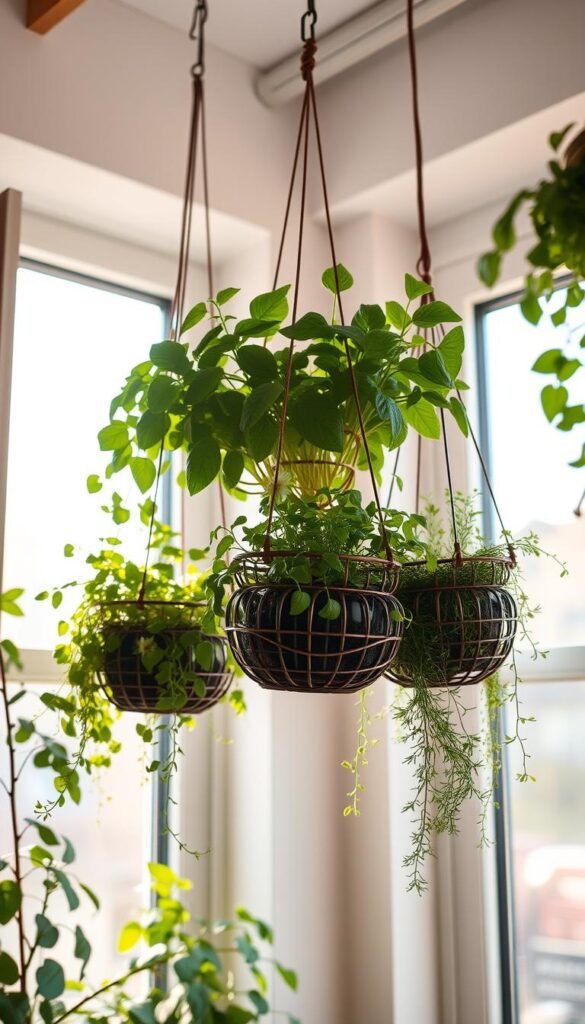
Turn your kitchen’s unused airspace into lush herb havens with vertical solutions. These clever designs keep flavors at your fingertips without cluttering surfaces – perfect when every inch counts.
Hanging Herb Baskets and Magnetic Jars
Macramé plant holders let trailing varieties like thyme spill downward beautifully. No counter space required – suspend them near sunny windows using ceiling hooks or tension rods. One urban gardener raves: “My oregano cascade doubles as living curtains!”
Transform cold appliances into green displays with magnetic herb jars. Stick spice varieties like basil or mint to fridge doors using strong adhesive magnets. This hack keeps flavors visible during meal prep while adding life to stainless steel surfaces.
Mason Jars and Tin Cans as Charming Alternatives
Repurpose glass jars into miniature ecosystems. Drill drainage holes in lids for inverted planters – roots grow downward while leaves reach upward. Line them along windowsills for a sunlit herb parade that mixes function with farmhouse aesthetics.
Old soup cans become cheerful planters with spray paint and imagination. Try chalkboard finishes for labeling varieties, or metallic hues that complement your decor. Pro tip: Use sandpaper to smooth sharp edges before planting kid-friendly options like chives.
DIY Indoor Herb Garden Projects
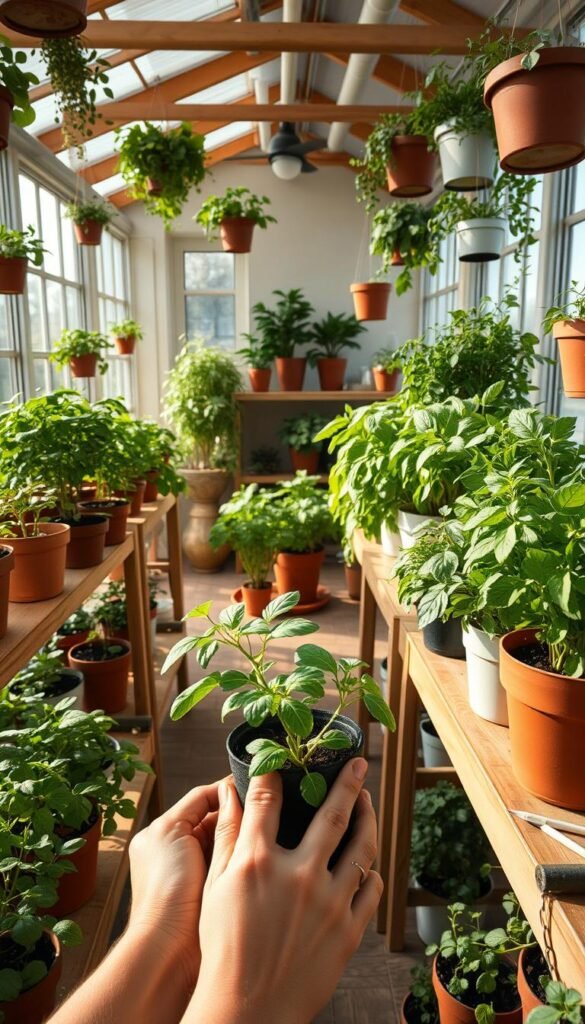
What if your next crafting session could stock your spice rack? Transform household items into living decor that grows fresh flavors. These projects prove beautiful planters don’t require fancy tools or big budgets—just creativity and everyday objects.
Step-by-Step Mason Jar Herb Garden Tutorial
Turn clear glass jars into hanging ecosystems in 20 minutes. You’ll need:
- Wide-mouth mason jars
- Potting mix with perlite
- Small basil or thyme plants
- Twine for hanging
Fill jars ¾ full with soil. Nestle plants into the mix, leaving ½” space. Secure twine around jar necks using this knot technique: loop twice, cross ends, then tie beneath the rim. Hang in sunny spots where you’ll brush past leaves while cooking.
Turn Everyday Items into Functional Planters
That empty lotion bottle? Rinse it, paint it mint green, and poke drainage holes. Voilà—a chic home for chives! Try these conversions:
| Item | Prep Time | Best Herbs |
|---|---|---|
| Wine box | 15 mins | Rosemary, Sage |
| Glass bottle | 10 mins | Mint, Oregano |
| Plastic tub | 5 mins | Parsley, Cilantro |
“I converted six shampoo bottles into a parsley wall garden during one Netflix episode,” shares DIY enthusiast Lara K. For wine bottle planters, cut the neck off with a glass cutter, then invert the top to create a self-watering reservoir.
Maximizing Kitchen Space with Vertical Displays
Your walls hold untapped potential for fresh flavors and visual flair. Vertical growing systems let you cultivate more varieties without sacrificing precious counter space. This approach turns blank surfaces into dynamic displays that work as hard as your spice rack.
Wall-Mounted Planters for a Sleek Look
Modern magnetic systems transform unused wall areas into productive zones. These planters cling securely to metal surfaces, keeping basil and thyme at arm’s reach while cooking. No drilling required—simply stick and grow.
For permanent installations, try modular rail systems with removable pots. Their slim profiles maintain a clean aesthetic while housing multiple herbs. “My magnetic wall garden makes garnishing soups feel like picking from a living spice rack,” shares New York chef Diego M.
Floating Shelves and Integrated Countertop Options
Floating wood shelves create the illusion of herbs hovering mid-air. Position them near windows to combine sunlight access with space-saving style. Use matching pots for cohesion, or mix materials for eclectic charm.
Built-in countertop planters offer seamless integration. These recessed systems nestle directly into your workspace, keeping parsley and cilantro within chopping distance. Pro tip: Add LED strip lights beneath shelves for 24/7 growth in dim corners.
Whether you choose wall-mounted marvels or space-conscious shelves, vertical displays prove that limited square footage can’t limit your green ambitions. Your kitchen becomes both functional workstation and living gallery—where every inch works double duty.

